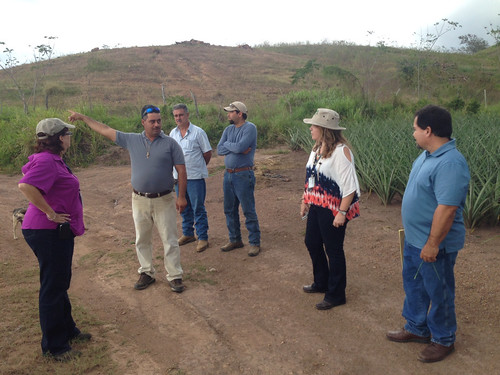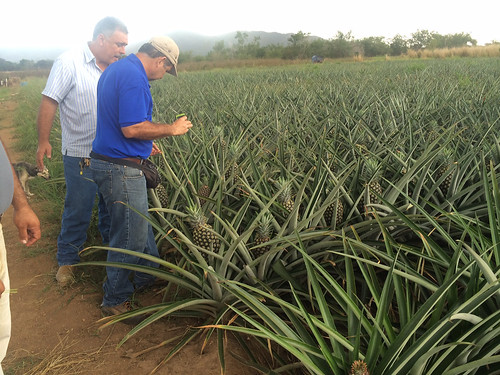

Pineapples are emerging again as a popular farming enterprise in Puerto Rico because of a new variety that packs more sweetness and boasts stronger harvests. USDA’s Natural Resources Conservation Service is working with pineapple farmers to prevent erosion, improve soil health and keep water clean downstream by encouraging them to use conservation practices.
The new variety is the golden pineapple, or Ananas Commosus vra MD2, which produces so much more fruit than the traditional Cabezona pineapple that farm acreage planted in pineapples on the island has doubled from 250 acres in 2011 to 500 acres this year.
Pineapple is an iconic crop in Puerto Rico, traditionally grown by Taino Indians since pre-Columbian times. It is native to southern Brazil and Paraguay and was likely domesticated by natives there and brought through South America and Central America to Mexico and the Caribbean islands.
Pineapple production was commercialized right after World War II and the fruit is typically grown on plantations in dense, close rows.
In Puerto Rico’s southwestern town of Lajas, the piña cabezona, or bull head pineapple, has been a cultural staple, adapted to the area’s soils and dry climate but with relatively low yields.

Over the past decade, farmers interested in increasing profits were moving away from planting pineapples until the University of Puerto Rico – Mayagüez Agricultural Extension Service introduced the golden pineapple.
USDA’s assistance comes through a new effort launched by the NRCS Caribbean area this year. NRCS provides technical and financial assistance for a number of conservation practices, including:
- Cover crops and reducing tillage to conserve soil, water and nutrients to improve soil health;
- Improving irrigation systems to capture, store and more efficiently transport and use scarce water supplies;
- Nutrient and pesticide management to ensure that farm chemicals are efficiently applied at the right time and place, which saves the farmer money and protects the environment; and
- Planting vegetative filters, stream buffers and other vulnerable areas to hold soils in place, filter pollutants and protect surface and groundwater.
Many farmers, especially those who run small or limited resource operations, in the southwest pineapple-growing area of Puerto Rico were unaware that conservation practices can save money through wise use of resources.
To help get the word out, staff from NRCS Caribbean Area met with pineapple growers from Lajas, San Germán and Sabana Grande counties earlier this year to explain the benefits of the NRCS conservation programs, including the Environmental Quality Incentives Program.
Staff also described the many conservation practices recommended for pineapple farms and helped each farmer complete a conservation program application.
“Now we can complete the re-birth of the pineapple industry because NRCS will provide the right technical assistance growers need,” said Jose L. Zamora, fruit specialist with the extension service.
